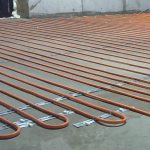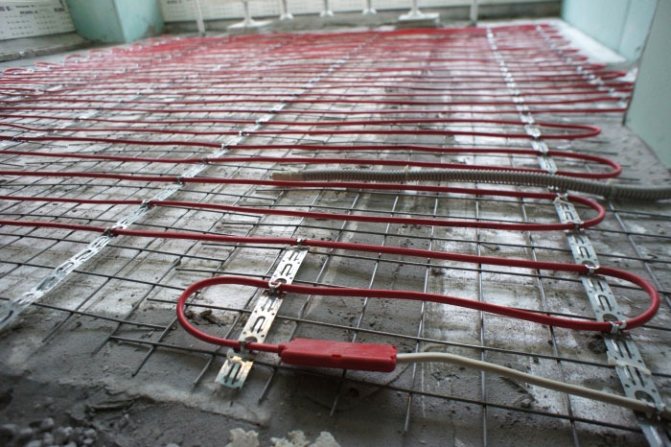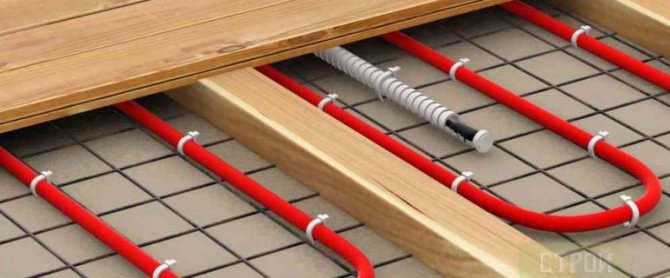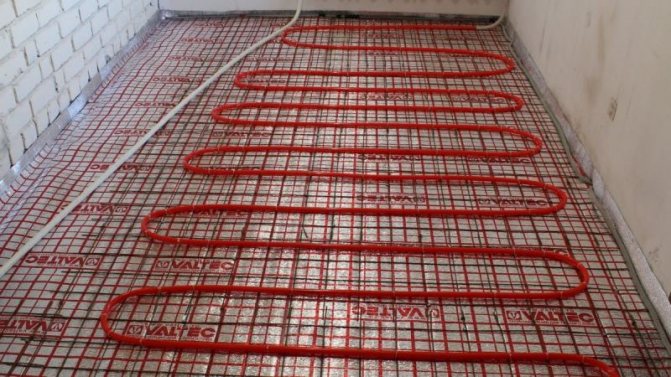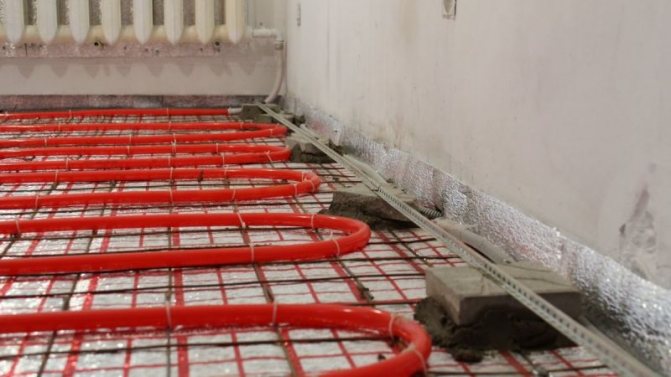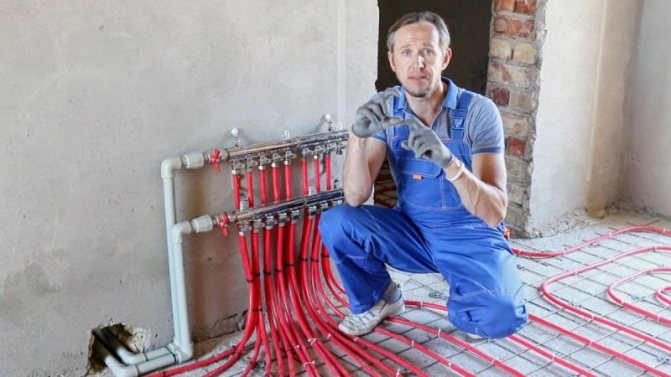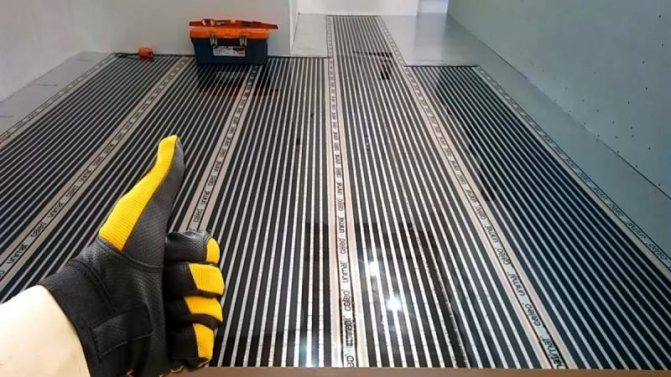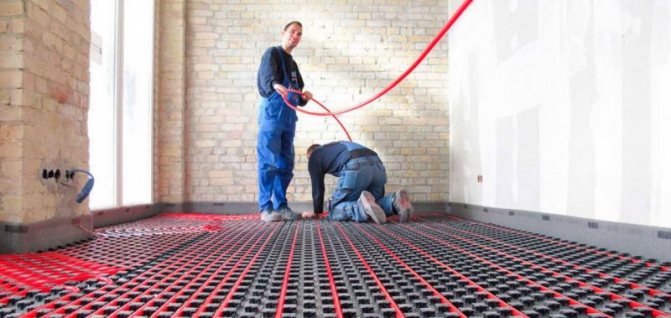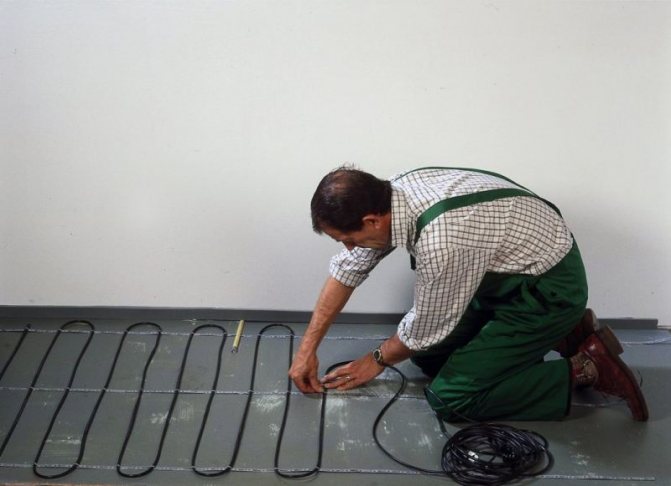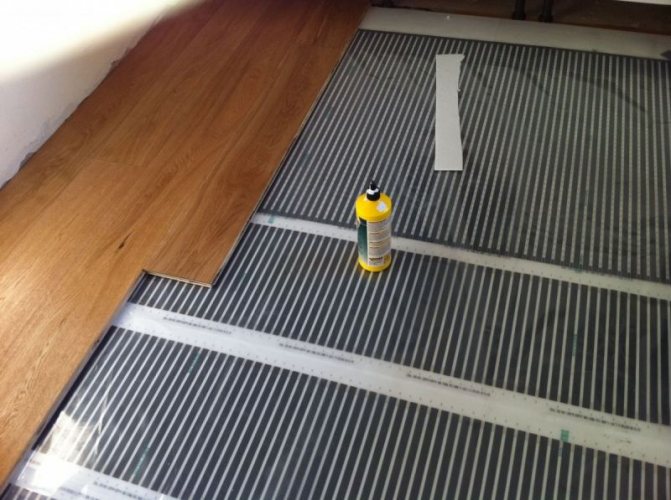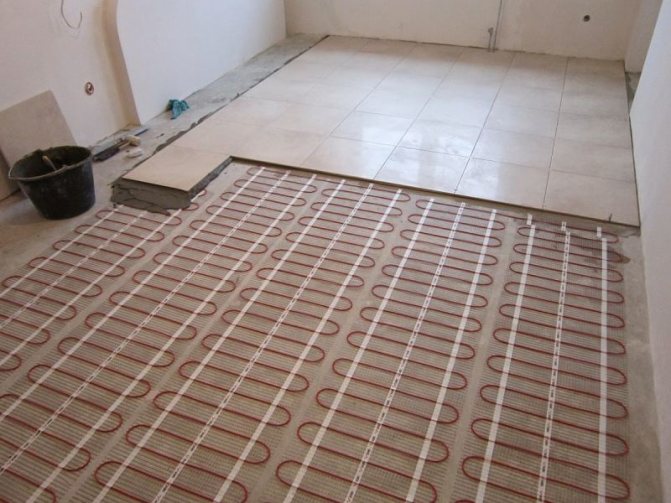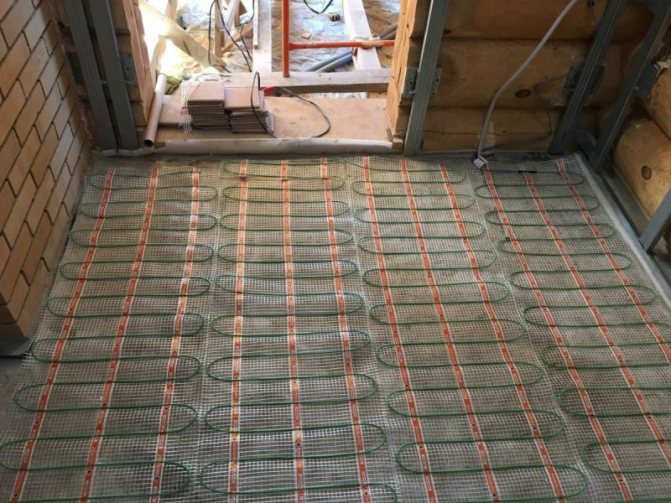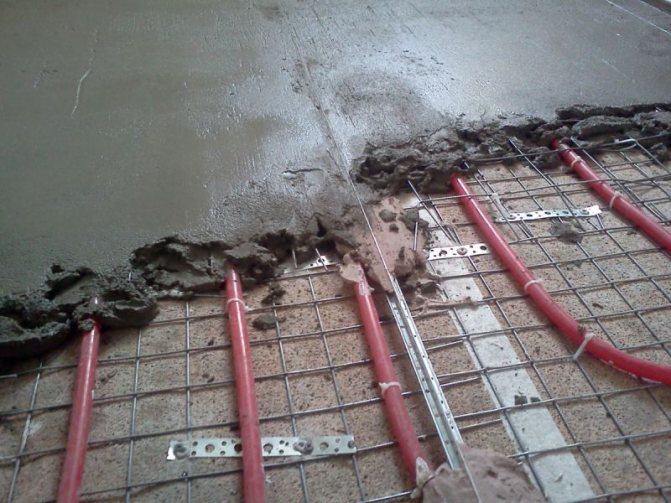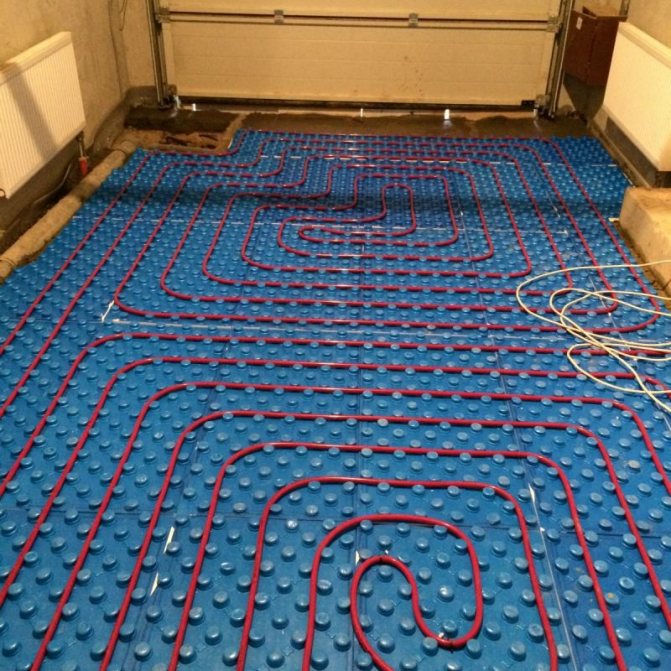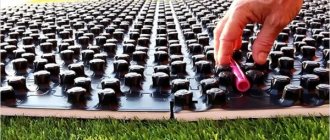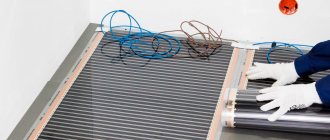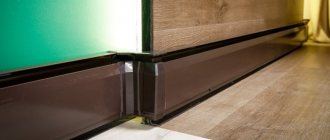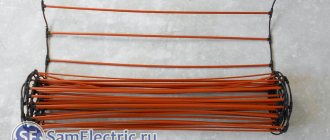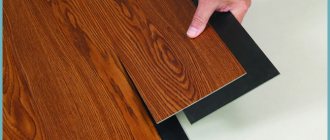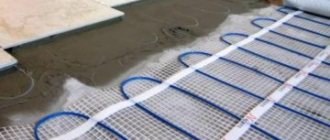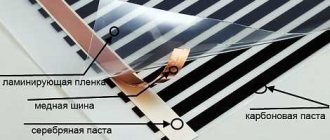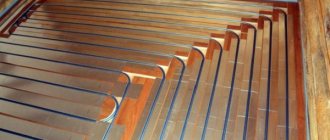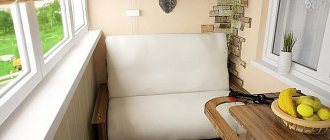Cable systems
The heating element here is a high-resistance conductor. Due to the high resistance, the core begins to warm up and give off heat to the floor. The most widespread is a two-core cable, the cores of which are connected at one end. The cable has external insulation and a metal braid (shield).
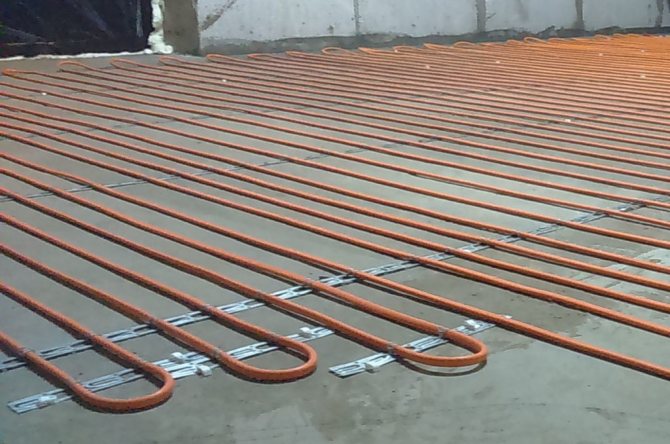
Installation is carried out using a metal tape with a zigzag conductor laying. Electricity and heating consumption largely depends on the step of laying the cable. On average, the power of a two-core cable is 110 - 150 W / m2, and an average of 7 running meters of cable are laid in 1 m2 of area.
The undoubted advantage of cable systems is their low price in comparison with other types of underfloor heating. So, for example, the Caleo Cable 18W-60, which costs 5800 rubles, is able to heat 8.3 m2 (the average size of the bathroom), while the heating mat will have to pay 30% more.
Underfloor heating models and their cost
There are various models of underfloor heating, each of which has its own heat transfer parameters, operation and installation features. In order to understand the issue, you need to understand that heating costs are divided into capital and operating costs. Capital expenditures are the money needed to purchase consumables and install equipment. Operating costs are the costs of keeping the system in good working order, that is, the cost of repairs and the payment for the energy carrier.
Water heat-insulated floor
A water-heated floor has both advantages and disadvantages. We will understand everything in detail, after which we will give approximate prices for the installation of this type of warm floor.
Cons of a water-heated floor:
- Hot water source required. If you live in an apartment, it is unlikely that you will be able to agree with the management company to switch the apartment to a warm floor system. The fact is that the apartments are designed for convection systems, which means that too hot water will flow into the warm floor: this will be uncomfortable for you and create a number of problems for the management company. Therefore, it is easier for the management company not to issue an achievement.
- Complexity of installation. Installation of a water heated floor is required in accordance with the project. The fact is that the scheme for the passage of pipes with water must be specified by a special calculation and fit with an accuracy of several millimeters. You cannot do this on your own, you will have to hire a professional.
- The need for a screed. In any warm floor, the heating surface is the floor. In the case of water floors, this is exactly the concrete surface. Therefore, the concrete layer must be at least 4 cm thick. This is a fairly thick screed, which is unacceptable for low-rise rooms.
- Repairs. The water underfloor heating requires replacement of the mixing unit every 5-6 years, as the old one becomes unusable.
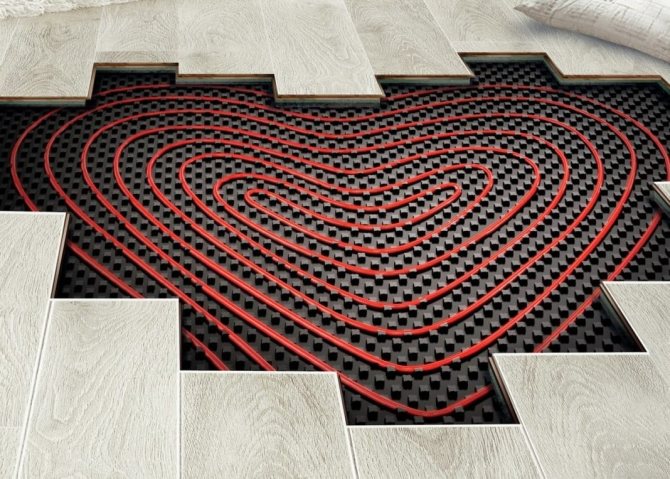

Water heat-insulated floor
At the same time, the water system has a number of advantages:
- For large rooms, this is the most economical system in terms of operation.
- The system does not require power consumption.
- It is possible to connect to boiler equipment in a private house.
- It can be used both as a main heating system and for air heating.
The decision to install a warm floor depends solely on the owner, but experienced heating technicians do not advise installing such a system in an apartment. It is ideal for private households.
If we talk about the price of installation, then taking into account the services of a specialist and consumables, such a floor will cost 19,000 rubles per 1 sq. M.But in private houses, such investments will pay off in savings in comparison with a convection system in 2-3 years.
Cable underfloor heating
Cable underfloor heating is considered an intermediate option between infrared film and water systems. The point of the installation is that a mesh with a heating cable is laid under the floor. The heating cable can be hidden under any floor surface. There is no need to bother with the calculation of the correct laying of the cable or the thickness of the screed. For the cable, ordinary sheet plywood or any other coating is enough.
But at the same time, such heating has one serious drawback: electricity consumption. That is, the operating costs will be 2-3 times higher than when using water systems. But you can use a thermostat, the program of which is able to set the floor heating by a certain time. This will reduce costs and make the floor suitable for use in small spaces. Large rooms cool down too quickly, so the thermostat may not always help.
Such systems can be installed in an apartment without any problems. Installation cost for 1 sq.m. will be approximately 1000 rubles. That is, the prices are several times less than the cost of installing a water system. But at the same time, the payback period also increases significantly, even with the installation of a thermostat.
Infrared film
Infrared film is a thin aluminum film sandwiched between two substrates. An electric current flows through this film with the release of heat. The big advantage of such a system is the possibility of self-assembly.
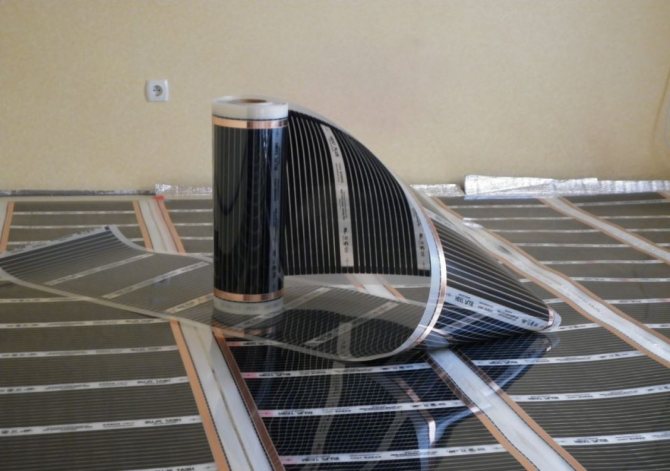

Infrared film
For such a film, it is much easier to arrange the floor, heating will occur more evenly than using a conventional heating cable. In this case, the cost of such coverage is 2000 rubles per 1 sq. M. ... It is slightly more expensive than installing cable heating, but electricity costs are several times less. The infrared film has more control possibilities, moreover, when using this version of the system, only the surfaces of the human body and the surrounding environment are warmed up, and the air is already heated from them. This method of heat transfer has a beneficial effect on the human body.
Heating mat
The heating mat is the same two-core cable, only attached to a plastic mesh. On average, the cable pitch is 9 cm. The advantage of the heating mat is in the installation method: it is enough to roll it out over the useful area of the room and fill it with a screed or lay tiles.
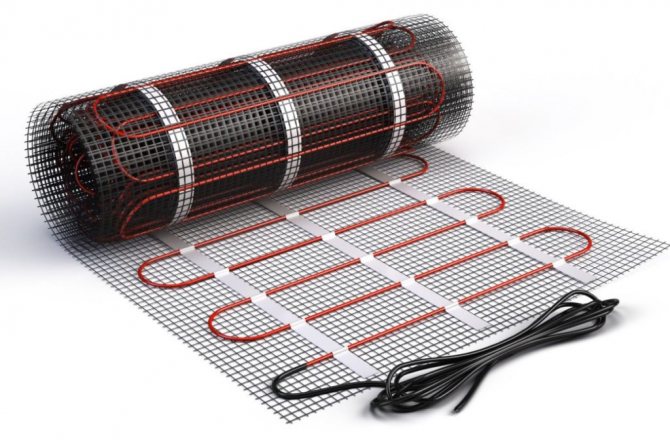

The power of the heating mats ranges from 130 to 150 W / m2, depending on the manufacturer. The maximum temperature to which the mat can be heated is 90 ° C. The cross-section of the conductors is 3.5 - 4 mm2. The ease of laying the mat is reflected in its price, which is significantly higher than that of a conventional cable. Here is a good heating mat STN Kvadrat heat KM-900-6.0 with a power of 150 W / m2.
IR film
The infrared film consists of a lower dielectric layer, carbon strips, which actually carry out heating, and an upper protective dielectric layer. The main advantage of IR film is a small layer thickness, as well as low heating (up to a maximum of 50 ° C), so that it can be used for laying under decorative coatings without additional screed. For example, it can be placed under laminate, linoleum or even carpet.
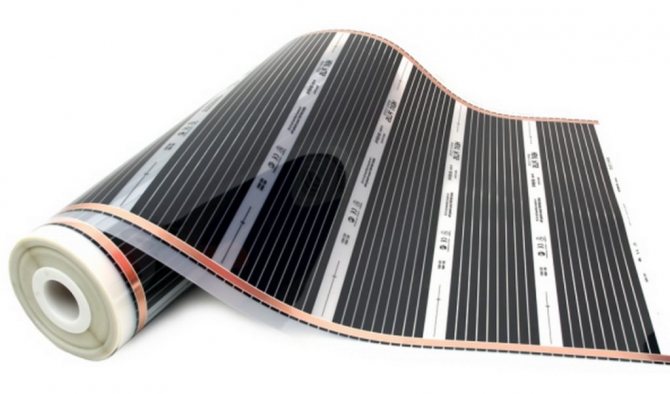

However, the power of the film is 220 W / m2, which significantly increases energy consumption compared to other types of underfloor heating. Also, due to the low operating temperature, the stacking ratio over the usable area will be higher. We recommend using the film only as an additional source of heating. Here is a good inexpensive IR film from Q-TERM:
Advantages of infrared film underfloor heating
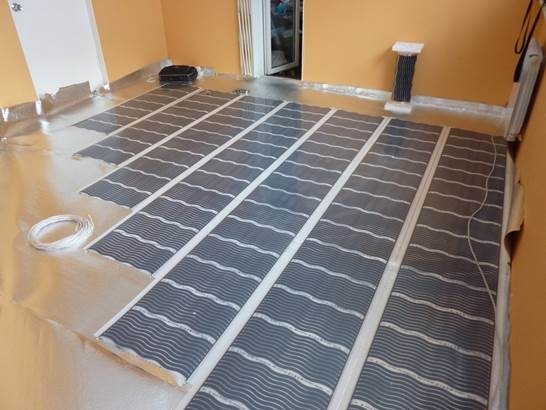

Infrared underfloor heating has the following advantages:
- The floor warms up quickly.It is comfortable to walk on it;
- The heating foil can be installed under laminate or linoleum, no need to pour concrete from above. Thus, materials are saved and the height of the room is not reduced. And also you can reduce the time spent on laying the floor. An infrared floor can still be arranged under parquet or carpet;
- When exposed to infrared rays, a favorable atmosphere is created in the room, and the air does not become dry.
Infrared carbon rods
IR bar floor is the evolution of cable and film systems. It is made in the form of a mat, only carbon infrared rods are used instead of a two-core wire. They emit infrared radiation that heats the floor. They are also mounted under a screed or glue. The operating temperature is almost the same as that of the film, about 60 ° C, but the power consumption is noticeably reduced and averages 120 - 160 W / m2.
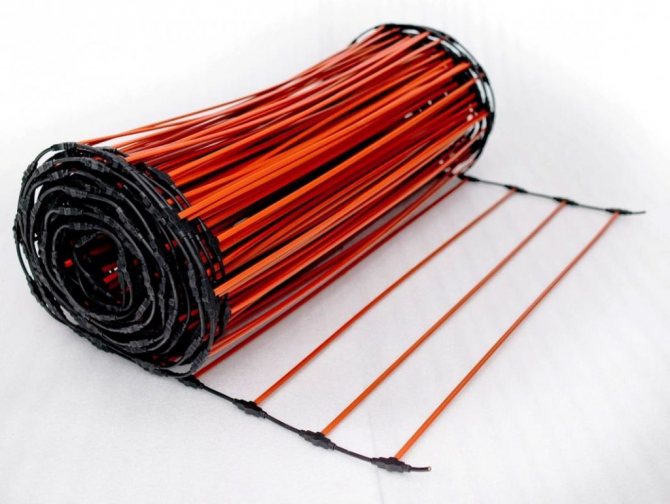

The core floor does not dry the air; you can safely put any furniture on it. Today it is the most expensive type of underfloor heating, and it is also used for the most part as an additional source of heating. For installation in a toilet, Unimat BOOST-0600 is suitable, which, with the total power of the heating elements, is capable of high-quality heating up to 4.98 m2 of usable area.
The principle of operation of the film and cable underfloor heating
Infrared film floor and cable are powered by electricity, but have a different principle of operation:
- Infrared underfloor heating is a thin film with sealed rods. The heating elements begin to emit infrared rays when an electric current passes through the film. Nearby objects begin to heat up quickly. In this case, the floor heats up.
- The cable floor heats the room with the cable. It has 1 or 2 conductors. They are made from materials that have high resistivity. The current passes through the veins, thus heating them, then the room is heated from the floor.
The difference in heating is as follows: the infrared floor heats the objects, and the cable floor heats the air in the room. The infrared floor seems to be warmer.
Energy consumption calculation
The table below shows a comparison of the average for each heating system. For more accurate data, you should pay attention to the characteristics of the product from the manufacturer.
| TYPE TP | Heating element power, W / m2 | Working temperature, оС |
| Two-core cable | 150 | 90 |
| Heating mat | 150 | 90 |
| IR film | 220 | 50 |
| IR carbon rods | 140 | 60 |
The calculation of electricity consumption is carried out according to the following formula:
W = P * S * 0.6, where P is the total power of the heating system; S is the area of the room; 0.6 is the coefficient of usable area (the one that is not covered by furniture, carpets and other items) - for maximum accuracy, you need to draw a drawing of the room with a complete arrangement of furniture and mandatory indents from the walls of 30 cm.
So, the calculation of electricity consumption per hour, on an area of 10 m2 (we take conditionally) for each product (we take the average indicators from the table) will be as follows:
- Two-core cable - 150 * 10 * 0.6 = 0.9 kW / h
- Heating mat - 150 * 10 * 0.6 = 0.9 kW / h
- IR film - 220 * 10 * 0.6 = 1.32 kWh
- IR carbon rods - 140 * 10 * 0.6 = 0.84 kWh
In this way, you can calculate the flow rate for each room. Then it is already necessary to multiply the result obtained by the operating time of the heated floor per day and we will get the exact amount that will have to be paid for the operation of the floor. But how long the warm floor will work per day already depends on the quality of the house insulation, heat loss and the level of room temperature that we want to get.
Roughly speaking, a warm floor working around the clock in a room of 10 m2 will cost you 120 rubles per day (one-rate tariff for Moscow).
In general, we can say that cable systems and a heating mat warm up the room the fastest (under the same installation conditions).However, they dry the air, reducing humidity, and are somewhat more difficult to install. In contrast, infrared emitters in the form of a film or rods are more gentle on the indoor climate, easier to install, but more expensive.
Saving methods with a warm floor
If you are using (or just planning) underfloor heating as the main source of heating, then the following methods will allow you to save money:
- Programmable thermostat... It can only be programmed to heat the floor during certain hours. On average, in winter, with good insulation of the apartment, the warm floor will work 8 - 10 hours a day. For example, you can set the system to work in this mode: 6:00 - 8:00, 16:00 - 22:00. Thus, the room will be warmed up before waking up and after coming from work. Of course, everyone sets the heating mode for themselves, depending on their work schedule and the need to maintain a certain temperature. You can use the Teplolux TP 515, an average-price thermostat, which is suitable for both electric and water floors.
- Multi-rate accounting electricity... We have already written about whether multi-tariff electricity metering is beneficial, which you can read about in the corresponding article. Here, we note that when connecting a multi-tariff meter, you can save money if you transfer the work of the heated floor to the night zone (23:00 - 7:00) or half-peak (10:00 - 17:00, 21:00 - 23:00). If the underfloor heating works exclusively at night, then the energy savings will be up to 55%. And provided that this system is the main source of heating, then the savings will be very significant.
If you know how else you can save money with a warm floor, share it in the comments!
Which floor heating to choose for a private house and apartment?
The selection of a floor heating system is carried out taking into account such factors as:
- the size of the room, in particular floor area and height;
- type of heating. Whether the underfloor heating system will be the main source of heating or an additional one will have a significant impact on its power.
Related article: Cleaning an old cast iron bathtub
What to look for when choosing a warm floor
- indoor setting... All underfloor heating systems, except for the infrared rod, are very sensitive to overheating, which means that they cannot be mounted under furniture and heavy household appliances. The minimum height is 350 mm. This often leads to the fact that one part of the floor is significantly warmer than the other. Uneven heating (temperature changes) negatively affects the wooden flooring (floor board, solid board, parquet);
- wall height... It should be borne in mind that some underfloor heating systems are mounted exclusively in a screed. This statement is true for a water heated floor, rod and electric with a heating cable or mats. The higher the height of the heating element (pipe diameter or cable section), the thicker the screed will be. If the height of the walls does not allow raising the floor by 70-100 mm, then film warm floors should be considered;
- system maintainability... The screed completely blocks access to the system elements, which creates additional problems in the event of a malfunction, i.e. cannot be repaired quickly. Even identifying the place of failure without dismantling the floor is problematic;
- speed of work... The speed of work is understood as the implementation of all types of work: from design to final surface finishing. Despite the fact that the core floor is installed within a few hours, it is not recommended to turn it on until the screed is completely dry, and some manufacturers (for example, Kaleo) set a limit of 28 days. The water floor is also mounted for a long time, which is associated with the specifics of the piping and also requires the complete solidification of the screed.The best option from the point of view of "operation immediately after installation" would be a film infrared heat-insulated floor.
- type of finish flooring... In many ways, the final choice is determined by the answer to the question, which warm floor is better for tiles, or which warm floor is better for laminate. Indeed, in one case, the use of glue is required, and not all systems are suitable for this, and in the other, it is necessary to take into account the tendency of wood to deform and the presence of harmful substances in the composition of materials (it is possible to release, for example, formaldehyde, when heated).
- profitability... Regarding which warm floor is more economical, users are unanimous and give the palm to rod floors for the economy of operation, and to water floors for the initial investment. But, is it always worth focusing on what is given cheaper? No, it is advisable to compare not by price, but to calculate the average costs for the operational period, and here infrared floors are in the lead.
As you can see, there are many factors that affect the final choice of a warm floor system, the fullest possible consideration of which will help to make the right choice.

